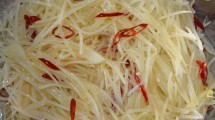Abstract
Effects of steeping temperature (15, 25, and 35°C) and steeping period (1, 11, and 21 days) on volatile compounds isolated from waxy rice and gangjeong made using steeped waxy rice were evaluated. Six acids, 4 alcohols, 2 carbonyls, 1 furan, and 2 hydrocarbons were detected in waxy rice. Acids and alcohols accounted for the majority of isolated compounds. Compositions of volatile compounds differed according to steeping temperature and time, probably due to changes in microorganisms and enzymes. Forty volatile compounds were isolated from gangjeong made using steeped waxy rice, including 3 acids, 7 alcohols, 10 carbonyls, 1 furan, 10 terpene hydrocarbons, 5 aliphatic hydrocarbons, 2 sulfur-containing compounds, and 2 miscellaneous compounds. Most volatiles were generated via lipid oxidation and decomposition. 2-Pentyl furan was the major volatile compound in gangjeong. Volatile aroma compounds from waxy rice and gangjeong made using steeped waxy rice varied according to steeping conditions and frying processes.
Similar content being viewed by others
References
Korea Food and Drug Administration. Report of foods and food additives yield in 2004. Korea Food and Drug Administration, Seoul, Korea (2005)
Kang SH, Ryu KH. Analysis of traditional process for Yukwa making, a Korean puffed rice snack (I), steeping and punching process. Korean J. Food Sci. Technol. 34: 597–603 (2002)
Lee YH, Kum JS, Ku KH, Kim WJ. Changes in chemical composition of glutinous rice during steeping and quality properties of Yukwa. Korean J. Food Sci. Technol. 33: 737–744 (2001)
Shin DH, Kim MK, Chung TK, Lee HY. Shelf-life study of Yukwa and substitution of puffing medium to air. Korean J. Food Sci. Technol. 22: 266–271 (1990)
Shin DH, Choi U. Yukwa quality on mixing of non-waxy rice to waxy rice. Korean J. Food Sci. Technol. 23: 619–621 (1991)
Jeon HJ, Shon KH, Lee MK. Characteristics on enzyme and microorganism by soaking time of glutinous rice. Korean J. Food Cook. Sci. 11: 104–107 (1995)
Shon KH, Park J. Effect of long-term steeping and enzyme treatment of glutinous rice on Yukwa characteristics (II): Physicochemical characteristics of enzyme-treated glutinous rice flour. Korean J. Food Cook. Sci. 14: 225–231 (1998)
Park J, Jeon HJ, Chung HJ, Jo MN. Effect of microorganism inoculation and enzyme treatment on Yukwa characteristics. Korean J. Food Nutr. 13: 213–220 (2000)
Chun HS, Lee MK, Kim HJ, Chang HJ. Microbiological and biochemical characterization of the traditional steeping process of waxy rice for Yukwa (a Korean oil-puffed snack) production. J. Korean Soc. Food Sci. Nutr. 9: 113–120 (2004)
Park YM, Oh MS. Effect of soaking on expansion volume of gangjung. Korean J. Food Sci. Technol. 17: 415–420 (1985)
Kim HR, Kim KM, Lee HS, Kim KO. Effect of steeping temperatures and periods of waxy rice on expansion properties of gangjung (a traditional Korean oilpuffed snack). Cereal Chem. 85: 314–321 (2008)
Woo KS, Yoon HS, Lee YR, Lee J, Kim J, Hong JT, Jeong HS. Characteristics and antioxidative of volatile compounds in heated garlic (Allium sativum). Food Sci. Biotechnol. 16: 822–827 (2007)
Woo KS, Yu SM, Im SK, Chun HK, Kwon OC, Lee JS. Changes in aroma compounds of several byeolmijang during aging. J. Korean Soc. Food Sci. Nutr. 33: 1689–1687 (2004)
Nickerson GB, Likens ST. Gas chromatographic evidence for the occurrence of hop oil components in beer. J. Chromatogr. A 21: 1–5 (1966)
Kim HR, Kim KM, Kim KO. Changes in microflora, enzyme activities and microscopic structure of waxy rice and steeping water in response to different steeping conditions during the preparation of gangjeong. Korean J. Food Sci. Technol. 41: 644–651 (2009)
Park HK, Sohn KH, Park OJ. Analysis of significant factors in the flavor of traditional Korean soy sauce (I)-Aroma compound analysis. J. Korean Soc. Food Cult. 12: 173–182 (1997)
Venkateshwarlu G, Chandravadana MV, Tewari RP. Volatile flavor components of some edible mushrooms (Boletales). Flavour Frag. J. 14: 191–194 (1999)
Zeng Z, Zhang H, Zhang T, Tamogami S, Chen JY. Analysis of flavor volatile of glutinous rice during cooking by combined gas chromatography-mass spectrometry with modified headspace solid-phase microextraction method. J. Food Compos. Anal. 22: 347–353 (2009)
Yoo SS. Changes of Korean traditional Yugkwa flavor and characteristics during storage. J. Korean Soc. Food Cult. 22:83–90 (2007)
Kim HR, Kim KM, Chung SJ, Lee JW, Kim KO. Effects of steeping conditions of waxy rice on the physical and sensory characteristics of gangjung (a traditional Korean oil-puffed snack). J. Food Sci. 72: S544–S550 (2007)
Lee TS, Choi JY. Volatile flavor components in takju fermented with mashed glutinous rice and barley rice. Korean J. Food Sci. Technol. 30: 638–643 (1998)
Yuda J. Volatile compounds from beer fermentation. J. Soc. Brewing Jpn. 71: 818–830 (1976)
In JP, Lee SK, Ahn BK, Chung IM, Jang CH. Flavor improvement of cheonggukjang by addition of yucca (Yucca shidigera) extract. Korean J. Food Sci. Technol. 34: 57–64 (2002)
Olias JM, Perez AG, Rios JJ, Sanz LC. Aroma of virgin olive oil biogenesis of the "green" odor notes. J. Agr. Food Chem. 41: 2368–2373 (1993)
Badings HT. Cold-storage defects in butter and their relation to the autooxidation of unsaturated fatty acids. Ned. Melk. Zui. 24: 147 (1970)
Brewer MS, Vega JD, Perkins EG. Volatile compounds and sensory characteristics of frying fats. J. Food Lipids 6: 7–61 (1999)
Ji WD, Lee EJ, Kim SY, Kim JK. Characteristics volatile components of traditional Korean soy sauce. J. Korean Chem. Soc. 35: 346–350 (1992)
Mazza G, Cottrell T. Volatile components of roots, stems, leaves, and flowers of Echinacea species. J. Agr. Food Chem. 47: 3081–3085 (1999)
Kim KO, Kim SS, Sung NK, Lee YC. Methods and Applications of Sensory Evaluation. Shinkwang Publishing Co., Seoul, Korea. pp. 335–336 (1993)
Author information
Authors and Affiliations
Corresponding author
Rights and permissions
About this article
Cite this article
Kim, HR., Kim, K.M., Woo, K. et al. Changes in volatile compounds of waxy rice and gangjeong (a traditional Korean oil-puffed snack) under different steeping conditions. Food Sci Biotechnol 24, 1565–1572 (2015). https://doi.org/10.1007/s10068-015-0202-0
Received:
Revised:
Accepted:
Published:
Issue Date:
DOI: https://doi.org/10.1007/s10068-015-0202-0




